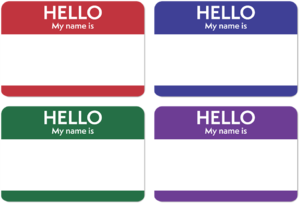Difference between revisions of "Documentation:Teaching English as an Additional Language"
m |
|||
| Line 5: | Line 5: | ||
===Alliteration Name Game=== | ===Alliteration Name Game=== | ||
In this game, students will say their name and then a word that describes them, but that word must start with the first letter of their name. They must also come up with an action to describe themselves. This is also a memory game. The first student will say for example, “My name is Kelly and I like kayaking (show motion of kayaking). The next student introduces themselves and repeats what the previous person stated. E.g. My name is Ana and I like art (motion of painting) Her name is Kelly and she likes kayaking. The game continues until all students have participated. | In this game, students will say their name and then a word that describes them, but that word must start with the first letter of their name. They must also come up with an action to describe themselves. This is also a memory game. The first student will say for example, “My name is Kelly and I like kayaking (show motion of kayaking). The next student introduces themselves and repeats what the previous person stated. E.g. My name is Ana and I like art (motion of painting) Her name is Kelly and she likes kayaking. The game continues until all students have participated. | ||
| − | |||
===My World=== | ===My World=== | ||
Draw a circle on the board and ask students what they think it is. After hearing their answers, tell them it represents your world. Write ‘My World’ above it. Then write a few words and/or phrases inside the circle that represent some things in your life (i.e.1980, elves, 5 years). Ask students what they think the words mean. Once they tell you their ideas, give them the correct answers (i.e. 'I love reading books with elves, etc.). Next, hand out blank pieces of paper and have the students draw a circle and label it as My World. Ask them to write 5-8 words/phrases that describe themselves. Put them in groups of 4 and ask them to guess about each other's 'worlds' | Draw a circle on the board and ask students what they think it is. After hearing their answers, tell them it represents your world. Write ‘My World’ above it. Then write a few words and/or phrases inside the circle that represent some things in your life (i.e.1980, elves, 5 years). Ask students what they think the words mean. Once they tell you their ideas, give them the correct answers (i.e. 'I love reading books with elves, etc.). Next, hand out blank pieces of paper and have the students draw a circle and label it as My World. Ask them to write 5-8 words/phrases that describe themselves. Put them in groups of 4 and ask them to guess about each other's 'worlds' | ||
| + | |||
| + | [[File:Hello.png|thumb|Name tags|300px|]] | ||
===Partner Interview=== | ===Partner Interview=== | ||
Revision as of 17:15, 9 September 2016
Warm Up Activities
Ice-breakers / Introductions
Alliteration Name Game
In this game, students will say their name and then a word that describes them, but that word must start with the first letter of their name. They must also come up with an action to describe themselves. This is also a memory game. The first student will say for example, “My name is Kelly and I like kayaking (show motion of kayaking). The next student introduces themselves and repeats what the previous person stated. E.g. My name is Ana and I like art (motion of painting) Her name is Kelly and she likes kayaking. The game continues until all students have participated.
My World
Draw a circle on the board and ask students what they think it is. After hearing their answers, tell them it represents your world. Write ‘My World’ above it. Then write a few words and/or phrases inside the circle that represent some things in your life (i.e.1980, elves, 5 years). Ask students what they think the words mean. Once they tell you their ideas, give them the correct answers (i.e. 'I love reading books with elves, etc.). Next, hand out blank pieces of paper and have the students draw a circle and label it as My World. Ask them to write 5-8 words/phrases that describe themselves. Put them in groups of 4 and ask them to guess about each other's 'worlds'
Partner Interview
Put students into pairs and tell them they will interview their partner and present them to the class. Include what town they are from, what grade they want to teach, and 2 other interesting facts they want to share (use `My World`` info). After 10 minutes, ask pairs to stand up and share about their partner.
Pictionary
Divide students into two groups. Explain that the game Pictionary is a guessing word games where teams try to guess what their team member is drawing (e.g. draw a book). For advanced students, give an example of something related to teaching that you will ask them to draw (e.g. Students are taking a test). Model that they can draw the noun, but the team should guess a full sentence. Have one student from each group come up to the board and give them the same sentence to draw a picture of. Remind the class to give the answer in full sentences (ex. Not simply ‘book’, but “a student is reading a book”).
Two Truths and a Lie
Ask each student to write down two sentences that are true about him or her and one sentence that is false. Then have the students read their list while the others listen and decide which one they think is a lie. Cycle through all the students.
We're Going Camping!
Introduce the game with the phrase, "Hello. My name's Kelly and we're going camping! I'm going to bring a kayak!" First letter of your name matches the first letter of the item you are bringing. The first student is coached to say, "Hello. My name is (D-----) and we're going camping! Kelly is bringing a kayak and I'm going to bring (d------)!" The next student says, "Hello. My name is (Y-----) and we're going camping! Kelly is bringing a kayak and D--- is bringing d--- and I'm going to bring (y------)!". This continues around the room, names and items added, with the teacher repeating the whole list at the end (hopefully).
Alibi Game
This game is designed to help students refine their questioning abilities, as well as to practice their listening and speaking skills. a.Start by describing a crime which happened last week. For example: On Friday afternoon around 3pm, there were 25 boxes of chocolate delivered to the school for the teachers to give to the students on Monday. They were held in the teacher’s lounge, but when the teachers came to school this morning, they were missing. There have been some rumours about some students having very strong opinions about chocolate - either loving or despising the treat, so the teachers suspect foul play). b.Have students get into pairs (or groups of no more than 3) and explain that each pair will be interrogated by the rest of the class and will create alibis to prove they are innocent. c.Have the students develop their alibis for where they were when the crime was committed. Encourage them to go into as much detail as possible when discussing their alibis. Optional: Go around the classroom getting an alibi statement from each group (e.g. We were away for a weekend trip to the countryside). Show the individual alibis on the document camera. Once each group has developed their alibis, ask them to write down three questions about the other alibis on the board. d.To begin the interrogation, ask one student from the beginning pair to leave the room. The other student sits in an interrogation chair in the middle of the classroom. Ask the rest of the students to put their metaphorical ``detective hats`` on and ask the first student questions. e.Ask the other student to return to the classroom and have the students ask the same questions. Take note of how many differences there were in the students' responses. f.Repeat the same with each student pair (or as many as time permits). g.The "guilty" pair is the pair with the most discrepancies in their story
Follow the Leader
This activity can be used to promote leadership and team building skills. a.Have students sit in chairs in a circle and ask one student to leave the room and wait in the hallway. In the classroom, choose a leader who will start a movement that everyone must copy (clasp hands, rub head, snap fingers, slap laps, etc.). The trick is that students should try not to look directly at the leader, but at someone else across the circle. b.As the leader starts the movement, ask the one student in the hall to come back into the classroom and guess who the leader is. c.After 2-3 rounds, ask for other tips that make a good leader (slow movements, change the motion when the person is not looking, etc.) d.Ask the following questions: Who was eventually copied and why? What steps did you take to conform to the same position? How comfortable was it to become exactly like everyone else or to go along with the peer pressure? Who resisted and why? e.At the end of the game, discuss the qualities of a great leader.

